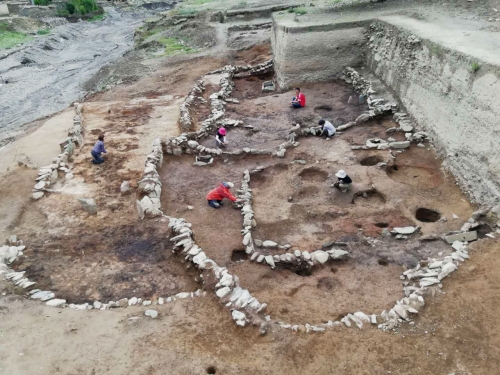
In conjunction with Northwest Agriculture & Forestry University, Washington University in St. Louis, USA, the Institute for Conservation and Research of Cultural Relics of Tibet Autonomous Region, the Center for Archaeological Science (CAS) of Sichuan University recently completed an important research on prehistoric yak domestication and cattle utilization on the Tibetan Plateau. The research findings were published online under the title of "Evidence for Early Domestic Yak, Taurine Cattle, and Their Hybrids on the Tibetan Plateau" in the renowned scientific journal Science Advances on December 13, 2023. This study has substantially advanced the understanding of academic issues such as the domestication process of yaks, the origin of high-altitude animal husbandry, and the flow of animal husbandry in high-altitude and neighboring regions. This is also the third paper that the CAS has published on major issues in archaeology on the Tibetan Plateau in Science Advances, achieving a series of breakthroughs.
“People living at high altitudes on the Tibetan Plateau have long relied for survival on domesticated and wild mammals adapted to extreme conditions. Domestic yak (Bos grunniens), taurine cattle (Bos taurus), and their hybrids are indispensable to the everyday life of people on the Tibetan Plateau today. Contemporary highland pastoralists rely on the strength and hardiness of domestic yak for transportation across vast mountainous terrain and for supplies of milk, meat, fiber, and dung for fuel. Cattle and yak-cattle hybrids complement yak, supporting herders under different conditions. Hybrids are hardy and productive at midelevations (approximately 2500 to 3500 m above sea level, henceforth m a.s.l.), and cattle are especially valued at low elevations. Little is known, however, about the timing and processes of yak domestication, the introduction of cattle across the Tibetan Plateau, and the early hybridization of yak and cattle.” (Introduction)
Exploration of the early history of bovine (cattle, yak, and hybrids) husbandry on the high Tibetan Plateau has been hindered by a lack of archaeological data because yak remains are rare, osteological discrimination between wild and domestic yak has not been fully investigated, and early cattle bones have seldom been found outside the northern fringes of the Tibetan Plateau.
In 2015, Prof. Hongliang Lv of Sichuan University joined efforts with the Institute for Conservation and Research of Cultural Relics of Tibet Autonomous Region, and Shannan Municipal Museum and conducted archaeological excavations in Bangga for four consecutive years. They discovered a large prehistoric stone architecture complex. Tens of thousands of animal bones, pottery fragments, stone products, carbonized plants, and animal feces were collected through systematic dry screening and flotation.
“--- To identify Bos taxa and investigate their initial management, we conducted zooarchaeological analyses of 193 Bos specimens and sequenced five nuclear genomes from recently excavated assemblages at Bangga. Morphological data indicated that more cattle than yak were present. Ancient mitochondrial DNA and nuclear genome sequences identified taurine cattle and provided evidence for domestic yak and yak-cattle hybridization ~2500 years ago. Reliance on diverse Bos species and their hybrid has increased cattle adaptation and herder resilience to plateau conditions. Ancient cattle and yak at Bangga were closely related to contemporary livestock, indicating early herder legacies and the continuity of cattle and yak husbandry on the Tibetan Plateau.” (Abstract)
The co first authors of this study are Ningbo Chen, associate professor from Northwest A&F University, Zhengwei Zhang, a post-doctoral fellow of the CAS, Jiawen Hou and Jialei Chen from Northwest A&F University. The co corresponding authors are Hongliang Lv of the CAS, Chuchao Lei of Northwest A&F University, Fiona Marshall and Xinyi Liu from the Department of Anthropology at Washington University in St. Louis, USA.

Hongliang Lv led a team to conduct archaeological excavations at the Bangga Site at an altitude of nearly 3800 meters.

Archaeological workers at Bangga Site
